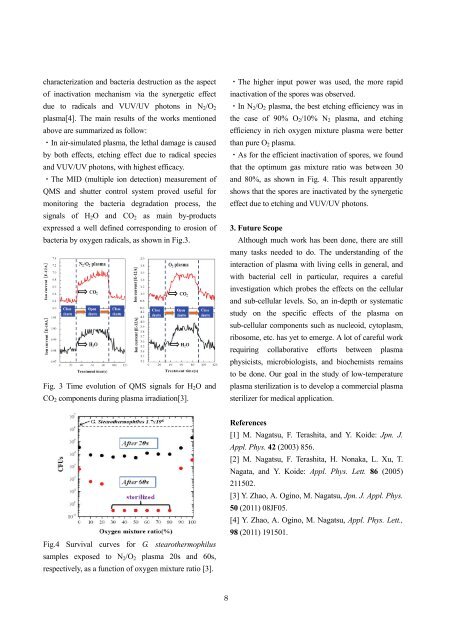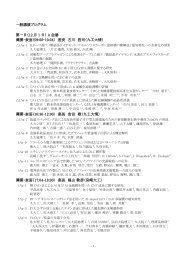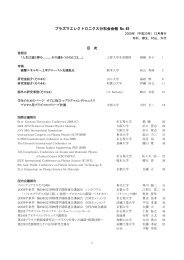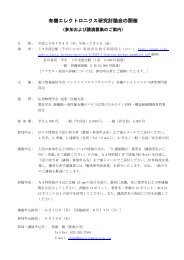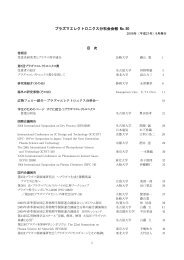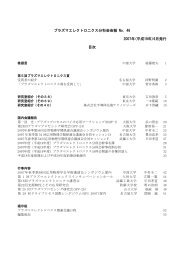プラズマエレクトロニクス分科会会報 No.56 - 応用物理学会
プラズマエレクトロニクス分科会会報 No.56 - 応用物理学会
プラズマエレクトロニクス分科会会報 No.56 - 応用物理学会
Create successful ePaper yourself
Turn your PDF publications into a flip-book with our unique Google optimized e-Paper software.
characterization and bacteria destruction as the aspect<br />
of inactivation mechanism via the synergetic effect<br />
due to radicals and VUV/UV photons in N 2 /O 2<br />
plasma[4]. The main results of the works mentioned<br />
above are summarized as follow:<br />
・In air-simulated plasma, the lethal damage is caused<br />
by both effects, etching effect due to radical species<br />
and VUV/UV photons, with highest efficacy.<br />
・The MID (multiple ion detection) measurement of<br />
QMS and shutter control system proved useful for<br />
monitoring the bacteria degradation process, the<br />
signals of H 2 O and CO 2 as main by-products<br />
expressed a well defined corresponding to erosion of<br />
bacteria by oxygen radicals, as shown in Fig.3.<br />
Fig. 3 Time evolution of QMS signals for H 2 O and<br />
CO 2 components during plasma irradiation[3].<br />
・The higher input power was used, the more rapid<br />
inactivation of the spores was observed.<br />
・In N 2 /O 2 plasma, the best etching efficiency was in<br />
the case of 90% O 2 /10% N 2 plasma, and etching<br />
efficiency in rich oxygen mixture plasma were better<br />
than pure O 2 plasma.<br />
・As for the efficient inactivation of spores, we found<br />
that the optimum gas mixture ratio was between 30<br />
and 80%, as shown in Fig. 4. This result apparently<br />
shows that the spores are inactivated by the synergetic<br />
effect due to etching and VUV/UV photons.<br />
3. Future Scope<br />
Although much work has been done, there are still<br />
many tasks needed to do. The understanding of the<br />
interaction of plasma with living cells in general, and<br />
with bacterial cell in particular, requires a careful<br />
investigation which probes the effects on the cellular<br />
and sub-cellular levels. So, an in-depth or systematic<br />
study on the specific effects of the plasma on<br />
sub-cellular components such as nucleoid, cytoplasm,<br />
ribosome, etc. has yet to emerge. A lot of careful work<br />
requiring collaborative efforts between plasma<br />
physicists, microbiologists, and biochemists remains<br />
to be done. Our goal in the study of low-temperature<br />
plasma sterilization is to develop a commercial plasma<br />
sterilizer for medical application.<br />
Fig.4 Survival curves for G. stearothermophilus<br />
samples exposed to N 2 /O 2 plasma 20s and 60s,<br />
respectively, as a function of oxygen mixture ratio [3].<br />
References<br />
[1] M. Nagatsu, F. Terashita, and Y. Koide: Jpn. J.<br />
Appl. Phys. 42 (2003) 856.<br />
[2] M. Nagatsu, F. Terashita, H. Nonaka, L. Xu, T.<br />
Nagata, and Y. Koide: Appl. Phys. Lett. 86 (2005)<br />
211502.<br />
[3] Y. Zhao, A. Ogino, M. Nagatsu, Jpn. J. Appl. Phys.<br />
50 (2011) 08JF05.<br />
[4] Y. Zhao, A. Ogino, M. Nagatsu, Appl. Phys. Lett.,<br />
98 (2011) 191501.<br />
8


